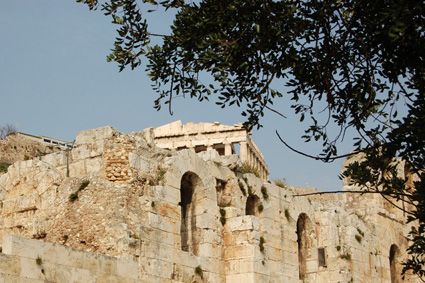
Parthenon atop Acropolis
We spent an absolute minimum of time in Athens, based on the following:
- No one we knew had good things to say about Athens. Reactions ranged from general ambivalence to outright hatred for the city. Even tourists in Paris sometimes love the place.
- The guidebook had a lot of charming things to note about the city, particularly with regard to fun aspects like pickpockets and taxi drivers renowned as some of the world's worst. Even the hotel, confirming our reservations, made sure to warn us specifically against the cab drivers trying to rip is off.
- We had a limited time in Greece to split between Athens and the islands. It's not as though it was a difficult choice.
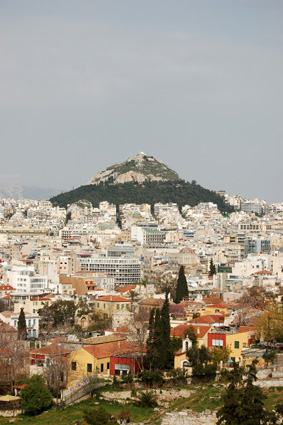
Athens, Greece
Our second pass through Athens was still brief, from the midafternoon when our ferry arrived from the islands, until our noon flight to London the next day. Still, there was enough time to race through the Acropolis, and that was all that I really wanted to do in Athens.
Our guidebook listed the wrong times for visiting the Acropolis, which meant that we arrived that first afternoon, at about 4:20pm, just ten minutes before they started to shoo people off the hill. Twelve euros seems like an awful lot of money to barely scurry up to the top, so we took note of the morning's opening time - 8:00am, giving us a little more than an hour to explore before racing off to the airport - and tried to see as much of it as we could from the outside.
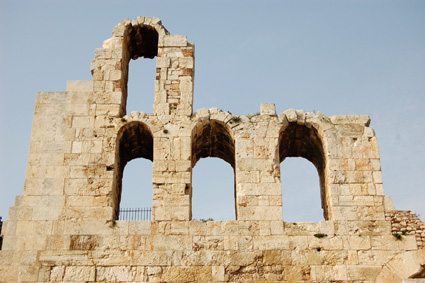
Facade of the Odeon of Herodes Atticus
Which, actually, was quite a lot. If you're willing to stretch a little, and stick your camera, arms, and sometimes head over and through the fences, you can almost make it seem as though you've seen all kinds of things that you simply walked past. And in Athens, where you can hardly go ten steps without running across another set of crumbling ruins, or little old church, or something else worth photographing. It's not the sort of place I'd want to live - the air pollution1 alone is enough to wipe it off the list of places I'll consider visiting again - but you sure can make it look lovely with pictures.

Temple of Hephaestus
Which is essentially what I plan to do. In the tweny-one hours we spent in the city - including the interminable wait at the airport, time asleep, and such - I managed to take about 175 pictures. The majority of those being at the Acropolis in one hour of the morning. It didn't leave much time for lengthy perusals of the signs or our guidebook, which means that, in some cases, I don't have a clue what it is that I've photographed.

Detail on Church of Agios Eleftherios
There's a patchwork, haphazard quality to Athens, much like we saw on Naxos. A cobbling of architectural styles - often the vernacular of various centuries - seems charming in some cases, but often more than a little sad. There's a sense that the city has begun to take better care of its ancient artifacts recently, but that, for centuries and longer, a great number of historical treasures were simply ignored, or worse.
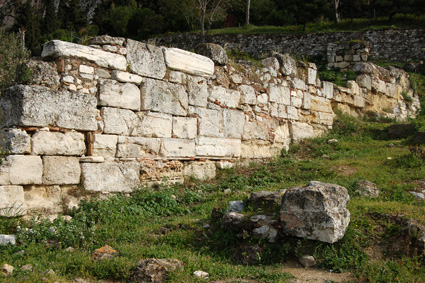
Ancient ruins on Acropolis slope
And Athens is full of tourists. Hordes of them, sometimes moving about in massive groups. I can't imagine what summer is like. Though I suppose that's what some people want - the packaged tour, bouncing from ancient sight to ancient sight, traveling about in the marginal comfort of a coach bus - but I'll pass. I've no desire to go on a cruise, either.
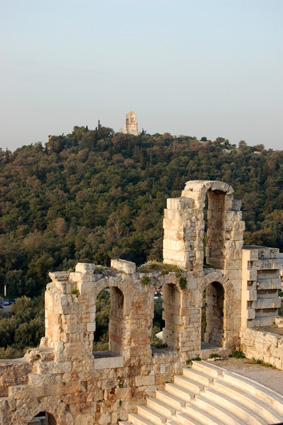
Odeon of Herodes Atticus from Acropolis
So, assuming you're like me, and you've made every effort to avoid the tourist-centric areas, as well as the accompanying crowds and crappy souvenirs, you'll be somewhat conflicted when it comes to ancient treasures like the Acropolis. You're guaranteed to find tourists of every imaginable stripe, and lots of them, but it's the Acropolis. Study enough architecture and you'll feel an almost overwhelming need to see it. A sense that there's something there, like the skies of the American west, that photographs just can't capture.2
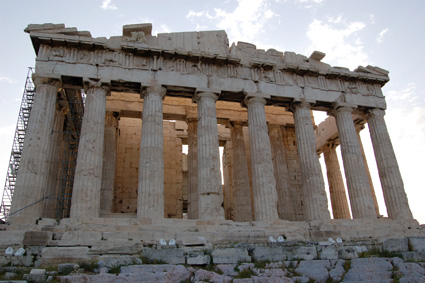
Parthenon, west facade at sunrise
As near as I can tell, the best time to visit the Acropolis is as soon as it opens in the morning. The package tours won't have their act together to arrive then, and the Greeks certainly aren't up and about - especially the vendors hawking junk. You won't have the place to yourself, but staying light on your feet means you'll have the best possible opportunities for keeping random people out of your shots.
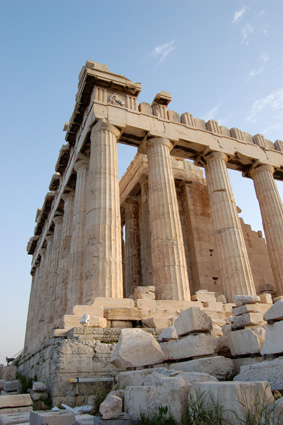
Parthenon, southwest corner
And the light... the rising sun, painting the ancient marble in warm sunlight, a sidelight with the sky still dark as a backdrop. It could only be finer with a richly colored, pollution-enhanced sunset behind.

Parthenon, east facade at sunrise
Scaffolding's an issue. The Parthenon has been undergoing a massive reconstruction project since 2000, and it's far from complete. When finished, it'll be brilliant, as close as possible to the state it was in before the invading Turks decided it'd be the handiest place to store gunpowder. But it does require some serious masonry work, including efforts to repair all of the mistakes made during the botched restoration effort in the early 20th century.

Altar of Rome and Augustus
Another problem is the occasional missing element. The Altar of Rome and Augustus is a pile of stacked ruins, awaiting reconstruction, which lends it the air of an organized mess. But the massive statue of Athena, which was supposed to have undergone restoration and to have been replaced in time for the 2004 Olympics, is still missing. And then there are the various bits and pieces, most taken by Lord Elgin, that are still in Britain3 despite repeated Greek requests to have them returned.
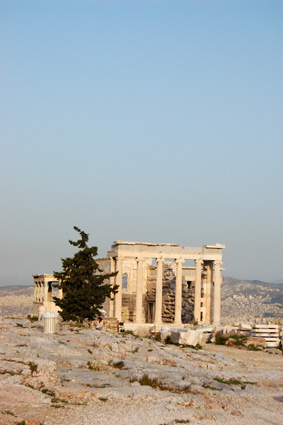
Erechtheion
In general, it's a rocky, slippery place on the Acropolis, with marble worn smooth by thousands of years' worth of feet wearing everything to a dull shine, rounding off the nosings of each stair tread. Not much of it is level, either, meaning that it's best to give your feet the occasional glance, lest you end up sprawled out in a most embarrassing fashion.
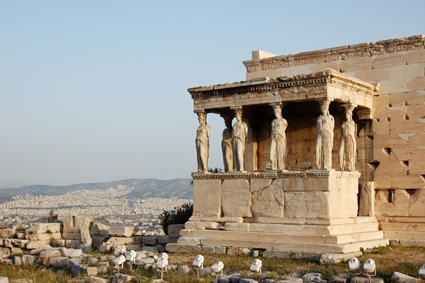
Karyatid porch of Erectheion
May I also recommend that, if you want good pictures, that you run around, shooting everything first and then return to read signs. By 8:30am, the first of the tourist groups - in our case, a bunch of thoroughly nonplussed Spanish adolescents who'd have rather been anywhere else - will begin to appear, often to start their day by watching the flag-raising ceremony at the east end. I'm not entirely clear on why it took six men with automatic weapons and camouflage uniforms to raise the flag, but that seems to be the case. Take advantage of everyone watching and get your last good pictures in.

Ancient artwork in Acropolis Museum
Then there's always the Acropolis Museum, a small collection showcasing many of the fascinating pieces artwork from about the Acropolis, preserved inside for close-up examination. Replicas replace them outside - in the case of the Karyatids - or will replace them, once restoration is complete. Beware the tour groups, however; it's a tight space for the volumes of people who move through.
On your way down, eventually, I recommend one of the many well-worn footpaths that will take you back to Athens without having to resort to the main road. You won't have them all to yourself, of course, but it's as close as you'll get. The trees temper the noise of the city, and, with a little luck, you'll see the little flowers and plants that are slowly tearing apart what's left of the ancient ruins.
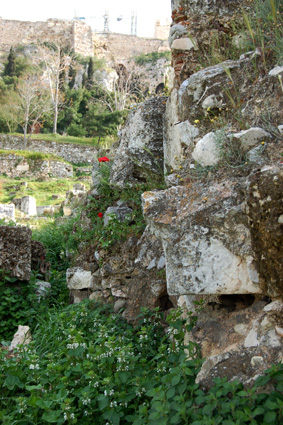
Poppies growing on ancient ruins
* * * * *
1When we arrived from the islands, stepping out from the subway at Monastiraki, Sharon asked if we were at a higher elevation. No, it was just about sea level, but the filth in the air was enough to make you feel like you were halfway to Machu Picchu.
2Same goes for these ones. Sorry.
3Including the Parthenon Marbles (also called the Elgin Marbles) and one of the Karyatids. I'm pleased to note that the new Acropolis Museum, when completed, will have empty spaces specifically reserved for these elements, which may finally be enough to prompt their return.

No comments:
Post a Comment